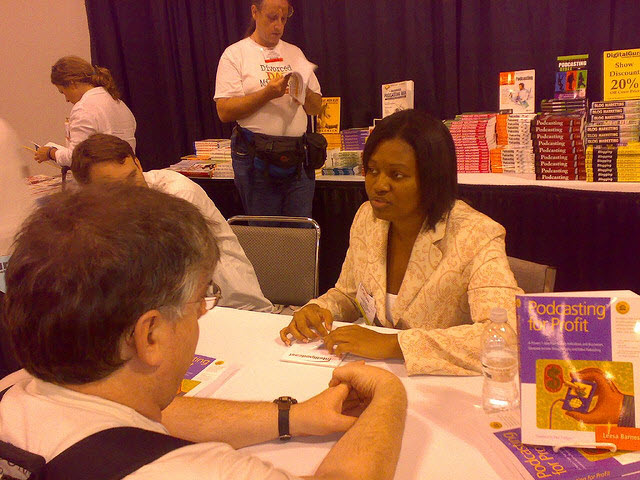I was at a networking event last week Thursday. Actually, I was asked to be a model in a fashion show showcasing the designs of Linda Lundstrom. But I still consider it to be networking because of all the business women in attendance.
While waiting to be fitted, I had a chance to sit down with Diane Brooks and her friend, I believe her name was Amanda. Amanda asked me what I did for a living. I told her that I’m self-employed and I help businesses use podcasting to fill their sales funnel.
Diane, who’s an image consultant, started raving about podcasting. Although Diane isn’t podcasting (yet), she told her friend that it’s the best way to communicate a message to your employees or customers.
Amanda then said, “But how can it work in my environment?” She’s in the HR department of a large Canadian retailer and she said that they have communications challenges between head office and the field (namely, each retail outlet).
Amanda said that podcasting couldn’t work because:
- Retail stores are geographically dispersed.
- Retail employees can only spare 5 to 10-minutes in a team meeting, then have to run back to the floor to help customers.
- Each store only has one computer and it may not have Internet connection, nor does it have the ability to play audio or video files.
- As much as she’d like this to happen, retail employees won’t access work related podcasts from their home computer (as Amanda says, who wants to do work at home?)
- And there were more, just can’t think of it right now.
Looking at the problems that Amanda described, podcasting can work, but I was stuck at how the solution would look. Does every employee get an iPod? Do we get Internet access into every store? Do we put Podcast Link in every store? And how much would all this cost?
For the first time in my life, I was stumped. Typically when people explain their marketing and communications issues, I can easily spout off a solution to their problem. But Amanda presented me with a challenge that I had to mull over for a few days.
I’m still mulling.
And while I’m mulling, Amanda’s situation really highlights an issue that those of us in the social media space don’t want to hear.
That while it’s important for people to engage in “the conversation” – meaning that it’s ideal to launch a blog, a podcast, and other social media tools to compliment your existing promotional tools – not every corporation or business can be part of this conversation.
Issues such as dispersed teams, language, geography, time, lack of technology are just some of the issues that plague organizational teams.
And, if it’s going to take a complete infrastructure overhaul and cost millions of dollars for a corporation to upgrade their technology just so they can launch a blog or a podcast, then this is a very expensive dialogue that’s not worth having.
Eric Rice posted on his blog that there’s a conversation we’re not having (thanks for the link C.C.). He was referring to the fact that social media consultants are neglecting to teach senior executives why social media is so important and why they need to get in the game.
I’ll take that one step further. The conversation we’re not having is understanding that not everyone can be a part of the conversation.
Technorati: corporate podcasting, blogging, Marketing, Business, social media, Podcasting



Leesa, it seems to me that the way to go here is to step back a bit. No internet connection? Can a cell phone work here? What about a CD or dare I say tape? Could the employees be asked (a nice word for told) to listen to a cd that’s in a break room? The podcasts would have to be very, very short, two or three minutes for them to fit them in. There’s always a recorded message on a telephone, too. What we’re really saying about podcasts is that people can receive something from audio content. MP3 is our audio of choice but it’s just that, our preferred audio delivery system. As a blind person, I’ve used a lot of audio delivery systems in my life … 33 1/3 rpm records, 16 1/2 rpm records, even 8 1/3 rpm records, reel to reel tape, cassettes at normal speed and special 4-track half-speed cassettes and now mp3 and digital braille books that certain devices can read aloud with synthesized speech. It’s all audio. It all had its place. Now MP3 and dsy (pronounced daisy) will be my audio of choice. ~Merrill